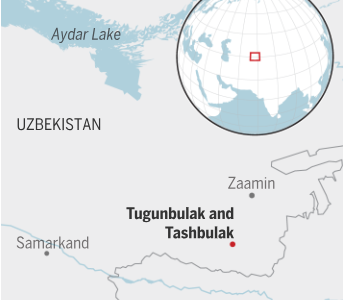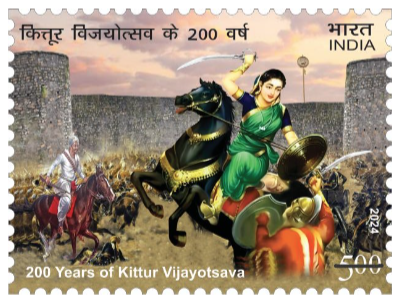Discovery of Two New Cities in Uzbekistan on the Silk Route
Syllabus: GS1/ History
Context
- Archaeologists have found the remains of two medieval cities, Tugunbulak and Tashbulak, in the mountains of eastern Uzbekistan on the Silk Route.
About
- Traditionally, the Silk Route was associated with plains and river valleys, believed to be the most accessible paths for trade.
- However, these new cities in elevated parts of Uzbekistan suggest that traders also traversed more mountainous regions.

| What is the Silk Route? – The Silk Route, also known as the Silk Road, was an ancient network of trade routes that connected the East (mainly China) to the West (Europe and the Mediterranean). – Spanning over 6,000 kilometers, the route facilitated the trade of goods, especially silk, along with spices, precious metals, ceramics, and other valuable items. – It played a crucial role in the cultural, economic, and political exchange between civilizations over centuries. |
Source: BBC
200 Years of Kittur Vijayotsava
Syllabus: GS 1/History
In News
- A commemorative postage stamp was released to celebrate the 200th anniversary of Kittur Vijayotsava, marking Rani Channamma’s victory against British rule in 1824.

About Rani Channamma
- She is celebrated as a freedom fighter and she symbolizes the independence movement in India.
- Early Life : Born on October 23, 1778, in Kakati, Karnataka, she was trained in martial skills from a young age.
- Married to Mallasarja Desai, king of Kittur, she became queen and had one son, who died in 1824.
- Kittur Conflict with British: After her son’s death, she adopted Shivalingappa as her heir, but the British denied the adoption, leading to conflict.
- She led an armed rebellion against the British East India Company in 1824, opposing the Doctrine of Lapse.
- She led the battle, where British forces faced heavy losses.
- In a subsequent battle, Chennamma was outnumbered and ultimately captured by the British, leading to her imprisonment at Bailhongal Fort.
- She led an armed rebellion against the British East India Company in 1824, opposing the Doctrine of Lapse.
- Death : Rani Chennamma died in imprisonment on February 21, 1829.
- Her burial site is maintained and honored during Kittur Utsava and Kannada Rajyotsava.
- Legacy: Her resistance inspired plays, folk songs, and stories, becoming a symbol of bravery in the Indian freedom movement.
- Statues of Rani Chennamma were unveiled in various locations, including the Indian Parliament, and a train named after her connects Bangalore and Kolhapur.
- A film titled “Kitturu Chennamma” was produced, depicting her life and struggles.
- Since 1824, ‘Kittur Utsava’ has been celebrated every October to honor her heroic rebellion.
Source :PIb
Justice Sanjiv Khanna Appointed Next CJI
Syllabus: GS2/ Polity and Governance
Context
- President Droupadi Murmu appointed Justice Sanjiv Khanna as the 51st Chief Justice of India.
Constitutional Provisions
- The Constitution of India does not mention any procedure for appointing the CJI.
- Article 124 (1) of the Constitution merely says, “There shall be a Supreme Court of India consisting of a Chief Justice of India.”
- Clause (2) of Article 124 of the Constitution says that every Judge of the Supreme Court shall be appointed by the President.
- Thus, in the absence of a constitutional provision, the procedure to appoint CJI relies on convention.
What is the Convention?
- The outgoing CJI recommends his successor a practice, which is strictly based on seniority.
- Seniority, however, is not defined by age, but by the number of years a judge has been serving in the top court of the country.
Eligibility
- Apart from being an Indian citizen, the person must;
- Have been for at least five years a Judge of a High Court or of two or more such Courts in succession or,
- Have been for at least ten years an advocate of a High Court or of two or more such Courts in succession, or
- Be, in the opinion of the President, a distinguished jurist.
Removal of CJI
- A Judge of the Supreme Court shall not be removed from his office except by an order of the President passed after an address by each House of Parliament supported by a majority of the total membership of that House and by a majority of not less than two-thirds of the members of that House present and voting.
- With the address in the same session presented to the President for removal on one of the two grounds: Proved misbehavior or incapacity.
Source: TH
Weather Forecast at Gram Panchayat Level
Syllabus: GS2/ Governance
Context
- The government launched the Weather Forecast at the Gram Panchayat level in New Delhi.
About
- The initiative will provide Gram Panchayats with a five-day weather forecast and hourly updates, enabling rural communities to better plan agricultural activities and prepare for weather-related risks.
- It is developed in collaboration between the Ministry of Panchayati Raj (MoPR) and the India Meteorological Department (IMD), Ministry of Earth Sciences (MoES).
- The initiative will deliver weather updates via e-GramSwaraj, the Meri Panchayatapp, and Gram Manchitra.
- The eGramSwaraj platform helps with project tracking and resource management, while the Meri Panchayat app promotes community engagement.
- The Gram Manchitra platform provides geospatial insights, aiding in spatial planning and development projects at the Panchayat level.
Source: AIR
World Polio Day
Syllabus: GS 2/Health
Context
- Every year October 24 is observed as World Polio Day, established by Rotary International, to commemorate the birth of Jonas Salk, who led the first team to develop the vaccine against the disease in the 1950s.
About: Poliomyelitis (polio)
- It is a highly infectious disease caused by a virus that invades the nervous system and can cause total paralysis in a matter of hours.
- Transmission: Through person-to-person spread mainly through the faecal-oral route or, less frequently, by a common vehicle (e.g. contaminated water or food) and multiplies in the intestine.
- Vulnerability: Mainly children under 5 years of age. However, anyone of any age who is unvaccinated can contract the disease.
- Symptoms: Fever, fatigue, headache, vomiting, stiffness of the neck and pain in the limbs.
- Prevention and cure: There is no cure for polio, it can only be prevented. There are two vaccines available: oral polio vaccine and inactivated polio vaccine.
Do you know?
- India was certified polio-free in March 2014 and continues to be so. In January 2011, India reported its last polio case, in West Bengal’s Howrah.
- According to the World Health Organisation, Pakistan and Afghanistan are the only countries in the world where polio remains endemic.
Source: IE
India’s Expenditure on Education: UNESCO Report
Syllabus :GS 2/Education
In News
- According to a UNESCO report, India’s expenditure on education surpasses that of countries like China and Japan.
Status and Findings
- India allocated approximately 4.1% to 4.6% of its GDP for education, aligning with the UN Education 2030 Framework for Action, which recommends a range of 4% to 6%.
- India’s government expenditure on education fluctuated between 13.5% and 17.2% of total public expenditure, meeting the Education 2030 target of 15-20%.
- The global average of public expenditure on education declined from 13.2% in 2010 to 12.5% in 2020, with further decreases noted post-COVID-19.
- Comparison: Reports from the UNESCO Institute for Statistics highlight that India’s investment is stable compared to a global decline in average education investment.
- India invests more in education than many neighboring countries in Central and Southern Asia, which typically allocate around 4-6% of GDP.
- Countries like Afghanistan and Pakistan are falling behind in education expenditure.
- Among Central and Southern Asian countries, India’s education expenditure is only lower than Bhutan (7.5%), Kazakhstan (7.2%), Maldives (4.7%), Tajikistan (5.7%), and Uzbekistan (5.2%).
- India invests more in education than many neighboring countries in Central and Southern Asia, which typically allocate around 4-6% of GDP.
Source :Air
MHA issues advisory to create ‘Special Wing of Cyber Commandos’
Syllabus: GS 3/Cybersecurity
Context
- Amid growing cyber threats, the Ministry of Home Affairs (MHA) issued an advisory to all states regarding the establishment of a Special Wing of Cyber Commandos.
About
- The formation of this Special Wing was recommended by the Prime Minister during the DGPs and IGPs Conference held in January 2023 and 2024.
- The Indian Cyber Crime Coordination Centre (I4C), overseeing this initiative, aims to deploy 5,000 Cyber Commandos in the next five years.
- These commandos will support state and central police organizations, focusing exclusively on cyber security tasks like digital forensics, incident response, and ICT infrastructure security. These Cyber Commandos will work within their respective police organizations.
- Currently, the first batch of 246 Cyber Commandos is undergoing six months of rigorous hands-on training at several prestigious institutions, including IIT Madras, IIT Kanpur, and the National Forensic Science University (NFSU) in Gandhinagar.
Need & Significance
- Recently, there is a rise in cybercrimes targeting crucial establishments and airlines which causes significant disruption, security threat and financial loss.
- The majority of these threats were created using virtual private networks (VPNs) or dark web browsers, eluding detection by investigative agencies.
- The cases of the digital arrest scam also rises, where cybercriminals “digitally detained” the persons and coerced them to pay money.
Source: DDNews
SIMBEX 2024
Syllabus: GS 3/Defence
Context
- The 31st edition of the Singapore India Maritime Bilateral Exercise (SIMBEX) began in the Eastern Naval Command at Visakhapatnam.
About
- SIMBEX, which began as ‘Exercise Lion King’ in 1994, holds the distinction of being the longest continuous naval exercise that the Indian Navy has with any other country.
- SIMBEX 2024 will be conducted in two phases – the Harbour Phase at Visakhapatnam and the Sea Phase in the Bay of Bengal.
- This year’s edition aims to further strengthen the strategic partnership between India and Singapore by enhancing interoperability, improving maritime domain awareness, and fostering cooperation to address common maritime challenges.
Do you know?
- The Singapore Army and Indian Army conduct bilateral exercises Bold Kurukshetra and Agni Warrior.
Source: PIB
Water Hyacinth
Syllabus: GS3/ Environment
In News
- The Andhra Pradesh Handicrafts Development Corporation is planning to impart training to artisans in manufacturing eco-friendly products and decorative material with water hyacinth.
About Water Hyacinth
- Water Hyacinth is called Gurrapudekka in Telugu, it is is a non-native aquatic invasive plant.
- It has a fibrous stem and is used in making various handicraft items, including handbags, table mats, baskets, and decorative pieces.
- It absorbs heavy metals and pollutants, making it useful in wastewater treatment, though its disposal after use requires careful management.
- Water hyacinth can block sunlight and deplete oxygen in water bodies, harming fish and other aquatic life.
Source: TH
Previous article
Private Sector Participation in Space
Next article
India’s Aadhaar system